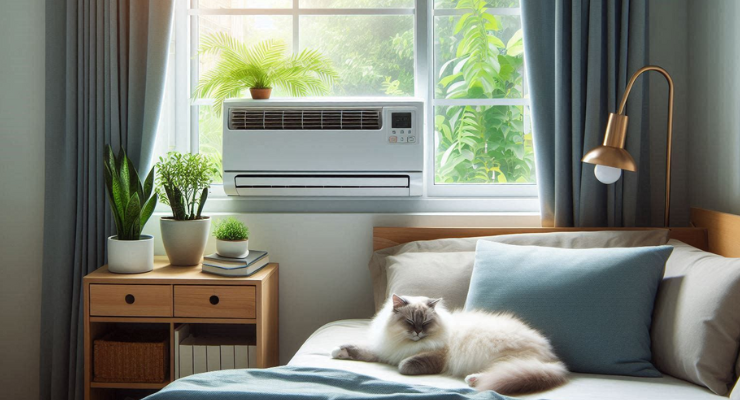Fast read
A window air conditioner is an affordable and effective way to cool a room. Mounted in a window, it uses refrigeration to cool air and expel heat outside. Key components include a thermostat, fan, refrigerant, compressor, evaporator coil, and condenser coil. Benefits include easy installation and portability, as well as running on standard 240V power.
However, they can be noisy, block natural light, and require regular maintenance to prevent dust buildup. If your unit isn’t cooling, check for low refrigerant or blocked filters. Regular maintenance ensures optimal performance.
What is a Window Air Conditioner?
A window air conditioner is a cheap and effective way to cool a medium-sized room in your home or office. It provides clean and comfortable air.
The unit is designed to be installed in a window. It comes in a sturdy steel cabinet. The unit delivers fresh and cosy air to the room.
The cooling coil brings cool air into the room when installed in an outer wall or window. The heated air from the condenser is released outside. This dual-function process ensures that the interior remains cool while expelling the heat outside.
How Does a Window Air Conditioner Work?
Understanding how a window air conditioner works can help you appreciate its simplicity and effectiveness. A window AC unit operates on the same basic principles as other types of air conditioning units, using refrigeration properties to cool the air and remove humidity from the room.
Key Components
- Thermostat: Senses the room temperature and activates the cooling cycle when needed.
- Fan or Blower: Circulates air over the cooling coils and back into the room.
- Refrigerant Tubing: Filled with liquid refrigerant that absorbs and releases heat.
- Compressor: Pressurizes the refrigerant, facilitating heat transfer.
- Evaporator Coil: Absorbs heat from the room air.
- Condenser Coil: Releases absorbed heat outside the room.
Heating Capabilities
Some window air conditioners offer a reverse cycle for heating, making them useful in cooler climates. This unit can be used all year round, providing both cooling in the summer and heating in the winter. It is a versatile addition to your home.
Pros & Cons of a Window Air Conditioner
Pros
- Cost-Effective: Generally less expensive to purchase and install compared to central air systems.
- Ease of Installation: Can be installed in any window or external wall without professional help.
- Versatile Power Options: Many units run on standard 240 Volt mains power and can be plugged into any household outlet.
- Portable: Can be easily moved from one window to another as needed.
Cons
- Noise: Can become noisy over time, which may be disruptive.
- Natural Light Blockage: May block a significant portion of natural light from the window.
- Efficiency: Not the most energy-efficient option, potentially leading to higher long-term costs if used extensively.
- Maintenance: Requires regular maintenance to prevent dust and pathogen buildup, which can affect performance and air quality.

Common Issues and Solutions
Cooling Problems
If your window air conditioner doesn’t cool effectively, it may be due to several reasons:
- Low Refrigerant: Insufficient refrigerant can hinder the cooling process.
- Blocked HVAC Filters or Coils: Dust and debris can block airflow, preventing efficient cooling.
- Blower Fan Issues: Malfunctioning fans can reduce airflow and cooling effectiveness.
Regular maintenance and cleaning can prevent these issues, ensuring optimal performance.
Power Issues
If your window air con doesn’t turn on, try the following steps:
- Check the Thermostat: Ensure it’s set to a temperature lower than the room temperature.
- Power Supply: Verify the unit is plugged in and the circuit breaker is not tripped.
- Reset the System: Turn off the master switch for a few moments and then turn it back on.
If the system still doesn’t work, contact a technician for a thorough inspection and repair.
When Should You Service Your Window Air Conditioner?
“Prevention is better than cure” is especially true for air conditioning systems. Regular checks and inspections can maintain the health of your AC and prepare it for peak seasons. Inspections should be scheduled in September, October, March, and April to avoid busy times in summer and winter.
Maintenance Tips
- Clean Filters: Inspect and clean filters every 6 to 8 weeks.
- Service Cooling Components: Regularly check and service the cooling coil, filter, and blower fan.
- Professional Inspections: Schedule professional inspections at least every six months.
Regular maintenance helps catch and fix problems early, keeping your window air conditioner in good shape.
Conclusion
A window air conditioner is a practical and efficient solution for cooling individual rooms or small spaces. Its simplicity, ease of installation, and cost-effectiveness make it an attractive option for many homeowners. Regular maintenance and proper usage can enhance its longevity and performance, providing reliable cooling comfort throughout the year.



